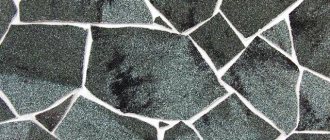Benefits of natural stone
The main advantage of the material is environmental friendliness and safety, which is very important in the modern environmental situation, where people are surrounded by dirty air and water, harmful radiation and products.
Natural stone, unlike artificial analogues, does not release chemicals during temperature changes.
The material is characterized by high strength and wear resistance, and is not subject to deformation under the influence of humidity and other climatic changes.
Another advantage of natural stone is its aesthetic appearance; the material is widely used in finishing work; recently, laying natural stone on paths has become widespread.
The range of shades and textures offered by nature itself can satisfy the most demanding client.
The only disadvantage of natural stone is its high cost, which is compensated by a large number of advantages.
Flagstone is considered the most suitable material for paving paths, as it is durable, versatile, and easy to install and operate. The technology is not complicated; laying natural stone on paths does not require the use of complex equipment or materials.
How to make garden lilies from plastic bottles step by step, read here.
Also find out how to plant a fast-growing perennial hedge and what shrubs to choose for it.
Advantages of laying natural stone
The key elements of the design of personal plots will be neatly paved paths. Natural stone is often used for these purposes. Regardless of size and color, it goes well with all types of landscapes. Natural stone is an unusual way to create a unique design, as well as a valuable decorative element, with the help of which individual objects of a personal plot are combined into a single whole. Beautiful paths made of natural stone can not only transform a garden plot, but also highlight the advantages of its surroundings.
A wide range of building materials on the market allows you to choose the type of stone that is best suited for paving in a given area. The ease of installation will not require additional costs or the involvement of the services of other workers. The stone material is very durable - without loss of properties or deformation, it can last for more than three hundred years. Long service life, as well as heat and cold resistance, make this stone one of the best materials for paths. A certain disadvantage is the high cost of natural stone. In addition, it is quite massive, and delivery to the construction site will require the help of a truck. In order to rationally manage the acquired resource, before starting to work with stone, you need to draw up a small project. This project will contain sketches of the future path, as well as all the necessary calculations for laying and paving. The combination of these indicators makes natural stone a rather valuable material. Some developers are afraid of the high price of such a product, but the quality offered by the manufacturer can rightfully be called elite.
Proper installation of natural stone is an environmentally friendly process and does not cause any harm to the environment. Various types of granite are not created at enterprises, but are mined in small quarries, only after which they are sent for processing. The natural origin of the resource serves as a guarantee of its quality and safety for the human body. Even long periods of use of the material do not show any negative features. Over time, natural stone does not deteriorate or change, maintaining its beauty and durability even after many years. Material of artificial origin often does not withstand temperature changes, breaks or cracks, but if this stone is natural, this will definitely not happen to it. By relieving the developer of the need to repair garden paths, durable and reliable stone will be a profitable investment.
Required materials and tools
To build paths, you will need the usual set of tools that any owner of a country house has at his disposal.
Required tools and materials:
- Master OK;
- Bulgarian;
- roulette;
- shovel;
- cord;
- pegs;
- cement;
- tamping;
- building level;
- watering hose;
- boards for formwork;
- metal brush;
- water;
- gravel;
- sand.
Paving methods
Depending on the purpose of the paths and the design of their base, there are different ways to lay natural stone.
When choosing a method, the groundwater level and soil type are taken into account.
Methods for paving paths with flagstone, depending on the composition of the base:
- the composition includes sand;
- the composition includes gravel;
- the composition includes a layer of concrete, usually reinforced.
The first method is suitable for constructing a regular garden path, since the loads in this case are minimal. The thickness of the flagstone should be 5-8 cm, the size of the stone should be as large as possible.
When paving a path intended for intensive use, as well as when laying stones on clayey and heaving-prone soils, the second method is recommended, the construction of which involves the use of a gravel cushion. The thickness of the stone in this case should be 4-6 cm, the size of the stone should be medium and large.
The third method is chosen when arranging a driveway, parking area or laying blind areas around the house, the thickness of the stone is 2-3 cm.
All methods of laying natural stone flagstone require its preliminary preparation: the material is thoroughly washed, dried, sorted by size and thickness, so that during the installation process it is more convenient to select individual elements according to the pattern. Strongly protruding parts of the stone are cut off with a grinder.
Laying stones on paths
Before choosing a stone for paving paths , it is necessary to determine the contours of the future path. Its length, dimensions and configuration depend only on the tastes of the owner of the summer cottage. If the outlines of the path are winding, they must be marked with a garden hose, thick rope, or sprinkled with fine sifted sand. After this, you need to dig a trench to the depth of a spade bayonet. Layers of turf removed during digging can be put aside, but not thrown away - it will later be needed to finish the path.
When the soil is removed and the ditch is cleaned, coarse material must be poured into the resulting hole. Slag, crushed stone, broken brick or pebbles work well as a filler. After backfilling and compacting the material, a layer of wet sand is poured over it. The following steps can be performed in two ways, depending on the type of soil and groundwater level at the installation site. According to the first method, stone tiles are laid on a sandy base and pressed tightly using a construction mallet. Every few meters of the laid covering, the tiles are fixed with a special solution. After the mixture of cement and sand fills the gaps between the stones and finally hardens, the path can be considered complete.
The second way to lay wild stone for paths begins with preparing the concrete solution. This solution is laid in a dense layer around the entire perimeter of the prepared trench area. Just as in the previous case, the stone material is laid with strong pressure. When a rigid bond is established between the stone and the concrete, the gaps between the individual slabs can be sealed with liquid cement.
Despite the simplicity of these processes, there are certain nuances in their technological cycle that must be adhered to. Finished paths for the garden must be raised above the ground level by a certain distance. In case of heavy rains or a sharp increase in humidity, water will not accumulate between the seams, but will flow down from the path. Protecting the stone material from water will strengthen the structure and make it more durable. To prevent the edges of the path from deforming during operation, they must be strengthened around the perimeter. For such strengthening, simple stone tiles or a special sidewalk curb cut from natural stone are suitable. It is also worth considering that some types of stone material are highly slippery, and therefore their placement on paths may be unsafe. Proper laying of stone on paths involves maintaining a balance between smoothness and roughness, and natural granite is best suited for this.
Paving a path on a gravel base
Step-by-step instruction:
- Marking the territory: for the pedestrian path the area must be at least 80 sq. cm, for the main entrance - 3 m.
- Digging a trench 20-30 cm deep, compacting the soil.
- Laying curb blocks along the walls of the trench or laying formwork from boards fastened together with self-tapping screws, covering them with a primer.
- Laying geotextiles.
- Fill the trench with a cushion consisting of an equal layer of sand and gravel, its thickness should be 30 cm.
- Watering, compacting.
- Laying flagstone, the gap between individual slabs is minimal;
- Carefully fill the joints with sand, to which you can add small crushed stone. With frequent use, an additional layer of thin concrete 2-3 cm thick is laid on the stones.
- Insulation of every 70-80 cm of surface with expansion joints.
The method of laying a path on gravel is used when this path is used intensively
Laying stone on concrete
A stone path laid on concrete has increased strength
This method is considered universal and is suitable for paving a wide variety of paths:
- Installation of formwork.
- Laying a gravel cushion on the ground, placing a reinforcing mesh.
- Pouring concrete mortar 20-30 cm thick, there should be no differences.
- After the base has dried, the stone is placed on a special glue, and the design is laid out in advance.
Laying natural stone with your own hands in all three ways requires maintaining a surface angle of 3 degrees, which will ensure water drainage from the surface.
Read about planting and caring for forsythia in this article.
We are planning a plot of 10 acres with our own hands: design and choice of style.
Laying natural stone
The choice of installation method depends on the type of soil and groundwater level at the construction site. If in some cases it is enough to lay the stone material on a sand cushion and fix it, then other situations will require compliance with a complex technological cycle. Traditional paving technology involves preparing a sub-base. The stone chosen for construction has natural irregularities and depressions in which water will be retained. For this reason, before installation begins, it is necessary to dig a sloping trench with gutters and drainage. On the sides of the paving area, profiles are constructed with a slope of one or two degrees.
Before laying natural stone for paths or preparing a site for a car, the soil must be compacted with a vibrating plate. If the density of the soil is unstable, it is prone to vibration or seasonal movement, a concrete screed is constructed at the installation site. During its construction, the selected area is marked out, graded and filled with concrete. While the concrete dries and hardens, it is necessary to sort the stone material by thickness, size and shape. To compare pieces of stone by configuration, they are washed in running water, cleaned with a special brush, dried and laid out near the construction site.
During the laying process, the largest and most beautiful stones are placed in the most prominent and noticeable places of the future path. When using the dry selection method, each subsequent stone is joined to the previous one with minimal gap sizes. The use of special saws with special cutting wheels allows you to independently form the contours of the stone material and not waste extra time on re-sorting.
Using construction adhesive to hold individual pieces together allows you to create the best stone garden paths . When the building material is laid on the base and sorted, it must be carefully removed in the reverse order, without disturbing the sequence, and the lower part of each stone must be lubricated with a special adhesive solution. The site itself is also covered with glue, having previously been washed and cleared of small building materials. The adhesive for installation must be homogeneous and retain plasticity. To achieve the required condition, it is diluted with cement or sifted sand. The white color of cement in combination with dark granite can create an interesting contrast effect. Using a special trowel, the adhesive solution is evenly distributed over the site, and then the stone material is laid on it and pressed tightly. The released excess glue is carefully cleaned off. It is important to ensure that there are no cavities left in the solution under the stone. If water gets into such a cavity, with a sharp change in temperature, the stone will then crack or move from its place. Also, during the installation process, it is necessary to monitor the level of the coating, avoiding rises or subsidence, and leveling the building material along the first stone.
The use of special technologies makes it possible to paving with natural stone , and to lighten it while the glue is drying. Until the solution has completely set, the construction site must be sprayed with water for several days, and then the color of the wet stone must be fixed by covering the path with a special impregnation.











